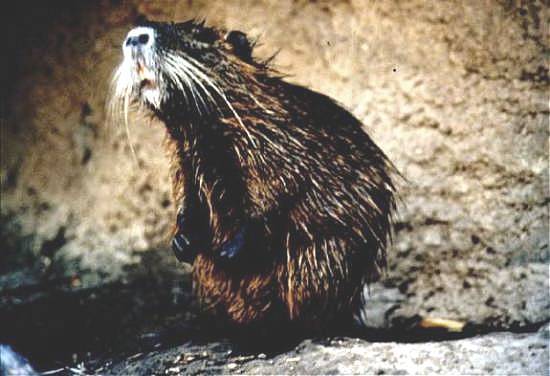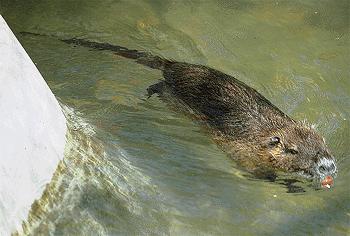Scientific Name: Myocastor
coypus
The Greek words mys (mouse) and kastor (beaver) led to the genus name
Myocastor. The latin form of coypu is the South American Indian
name for this animal.
(Georgia Museum, 2000)
Other Scientific Name: Myopotamus
bonariensis (GSMFC, 2005)

Classification:
Phylum or Division: Chordata
Subphylum: Vertebrata
Class: Mammalia
Subclass: Theria
Infraclass: Eutheria
Order: Rodentia
Suborder: Hystricognatha
Infraorder: Hystricognathi
Family: Echimyidae
Subfamily: Myocastorinae
Identification: A large rat-like rodent which
is brown
in color with a white muzzle and chin. The outer fur is dark
brown
and coarse while the underfur is softer and gray. While males are
usually bigger than females, the average size of the head and body is
521mm while the average length of the tail is an additional 375mm.
It has large, orange, protruding incisors. The hind feet
are webbed and the tail is
long, rounded and scaly with little hair. It is also similar in
appearance
to the beaver and the muskrat, although the tails of each are
different.
Original Distribution: Native to South America, specifically middle Bolivia and Southern Brazil to Tierra del Fuego
Current Distribution: South America, Europe, Asia, North America (Atlantic and Pacific coasts, and from Texas and the Gulf States north through Maryland) in aquatic and marshland communities.
Site and Date of Introduction: Farmed for their fur, 'escapes and liberations' from fur farms in South America led to feral populations which mutliplied and spread rapidly. (D'Elia, G., 1999) Additionally, this species was introduced into North America intentionally in the early 1930's for its fur and in later years to control aquatic vegetation. (GSMFC, 2005)
Mode(s) of Introduction: Nutria were captured in South America and released in Louisiana for trapping and pelting purposes; Escapes or releases from Louisiana and other fur farm captivity led to the widespread feral populations in North America. (GSMFC, 2005)
Reason(s) Why it has Become Established:
Reproduction in this species is very high. Breeding occurs
throughout the year, and
sexual maturity may be reached in as little as four to eight months of
age.
Gestation lasts just over four months, and the litter size can
range
from one to eleven although the typical litter is four to six.
Females typically have two to three litters per year.
Although the species prefers fresh water and lowland areas, there exist
populations in salt and brackish water and in higher elevations.
All populations of this species, however, are found in habitats
close to wetlands - swamps, marshes, rivers and lakes, particularly
those with vegetation along the banks. Although initially farmed
for their fur, the downturn of the fur market and human preference
for muskrat fur has resulted in less hunting of this animal.
Their primary
predators in the wild are alligators, turtles, gars, large snakes,
birds
of prey, and to a small extent now, humans (for fur or meat).
They are
nocturnal and thus may not be easily preyed upon by daytime predators.
Their
lifespan is approximately six years over which time the amount of
offspring
produced is tremendous.

Ecological Role: The nutria is an herbivore, although coastal nutria have been known to consume shellfish as well. They eat primarily aquatic vegetation and can consume up to 25% of their body weight each day. They consume the entirety of a plant including the stems, leaves, roots and bark. As indicated above, the nutria's diet puts it in direct competition with the muskrat and various waterfowl. Predators are also listed above. In limited quantities, nutria would serve a very useful purpose in thinning waterways choked with vegetation.
Benefit(s): This animal is valued for its fur and in some places its meat. It is also valuable for its ability to consume vast quantities of aquatic plants - weeds and vegetation - which can reduce the over-vegetation of aquatic areas such as ponds, lakes and marshes.
Threat(s): The Nutria is too efficient at eating which is threatening habitats, native plants and other wildlife. Their high reproduction rate and resulting overpopulation is stretching limited trophic resources and threatening other species such as waterfowl (ie. bitterns and marsh harriers) and muskrats. By consuming the young and fragile plants in an area, they are capable of turning marshes into vast stretches of open water. Their burrowing actions damage habitats, dikes and levees. They also cause considerable damage to various crop areas such as soybean plantations, rice plantations, sugar cane fields, and sea oats (which stabilize Mississippi's beach dunes) (GSMFC, 2005). Nutria also carry and can transmit various parasites and diseases.
Control Level Diagnosis: Medium Priority. While this species is thought to be declining in South America due to the fur trade (D'Elia, G., 1999), in North America, it seems that this species has gained a significant foothold which is only increasing over time in terms of both overpopulation and damage to wetlands. Several states including Texas, Georgia and Maryland have already begun attempts at decreasing or eradicating this animal.
Control Method:
Georgia has attempted control of small or medium sized nutria
populations through shooting and trapping. (Bertolino, 2005) At
least one county in Texas has spent hundreds of dollars trying to
eradicate this animal.( NSRL)
Maryland, greatly concerned about the nutria's effects on the
marshes
on the lower eastern shores, proposed a ten year nutria eradication
program.
The program was postponed pending the results of a two year study
to
determine whether "exclusion of nutria from emergent marsh habitats can
stabilize
or recover marsh vegetation." (Haramis, 1996) It is unclear
whether
this program was actually instituted. It is also unknown whether
the
efforts undertaken resulted in the eradication of nutria or reduction
in
damage to wetlands in specific locales.
References:
Bertolino, 2005. "Mycastor coypus" (On-line), Invasive Species Specialist Group database. Accessed November 11, 2005 at http://www.issg.org/database/species/ecology.asp?si=99&fr=1&sts=sss.D'Elia, G. 1999. "Myocastor coypus" (On-line), Animal
Diversity Web. Accessed November 11, 2005 at http://animaldiversity.ummz.umich.edu/site/accounts/information/Myocastor_coypus.html.
The Georgia Museum of Natural History and Georgia Department of
Natural Resources, 2000. "Nutria" (On-line), Georgia Wildlife Web
Site. Accessed November 12, 2005 at http://museum.nhm.uga.edu/gawildlife/mammals/rodentia/myocastoridae/mcoypus.html.
Gulf States Marine Fisheries Commission (GSMFC), 2005.
"Myocastor
coypus" (On-line), Gulf States Marine Fisheries Commission Web Site.
Accessed November 12, 2005 at http://nis.gsmfc.org/nis_factsheet.php?toc_id=213.
Haramis, M., 1996. "The Effect of Nutria (Myocastor coypus)
on Marsh Loss in the Lower Eastern Shore of Maryland: an
enclosure study" (On-line), United States Geological Survey Web Site.
Accessed November 11, 2005 at http://www.pwrc.usgs.gov/resshow/nutria.htm.
National Science Research Lab (NSRL) [no specific author or date
noted].
"Nutria" (On-line), The Mammals of Texas - Online Edition.
Accessed
November 11, 2005 at http://www.nsrl.ttu.edu/tmot1/myoccoyp.htm.